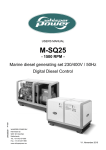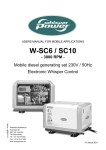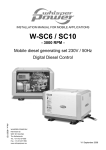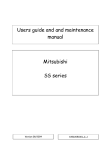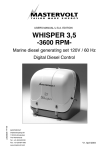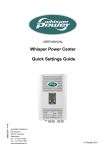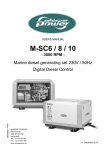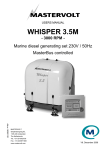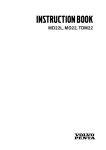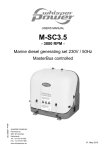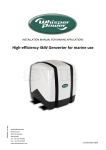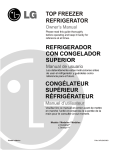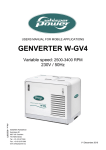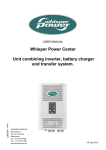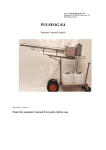Download Whisper Power W-SQ20 Technical information
Transcript
USERS MANUAL FOR MOBILE APPLICATIONS W-SQ20 - 1500 RPM - Mobile diesel generating set 230/400V / 50Hz Digital Diesel Control Art.nr. 40200626 WHISPER POWER BV Kelvinlaan 82 9207 JB Drachten Nederland Tel.: +31-512-571550 Fax.: +31-512-571599 www.whisperpower.eu V1 April 2010 CONTENTS CONTENTS: 1 INTRODUCTION .............................................................................................................................................................. 4 1.1 General .............................................................................................................................................................. 4 1.2 Service and maintenance ................................................................................................................................... 4 1.3 Guarantee .......................................................................................................................................................... 4 1.4 Liability ............................................................................................................................................................... 5 1.5 Identification ....................................................................................................................................................... 5 1.5.1 General.............................................................................................................................................. 5 1.5.2 Identification plate ............................................................................................................................. 6 2 INFORMATION ................................................................................................................................................................ 7 2.1 Safety ................................................................................................................................................................. 7 2.1.1 General.............................................................................................................................................. 7 2.1.2 Electrical safety ................................................................................................................................. 7 2.1.3 Earth insulation failures ..................................................................................................................... 7 2.1.4 Installation ......................................................................................................................................... 7 2.1.5 Operation ........................................................................................................................................... 8 2.1.6 Fire and explosion ............................................................................................................................. 8 2.1.7 Chemicals .......................................................................................................................................... 8 2.2 Transport, lifting and storage .............................................................................................................................. 9 2.3 The W-SQ20 ...................................................................................................................................................... 9 2.3.1 Features ............................................................................................................................................ 9 2.3.2 Remote control .................................................................................................................................. 9 2.3.3 Documentation .................................................................................................................................. 9 2.4 Components ..................................................................................................................................................... 10 2.4.1 Main components to identify ............................................................................................................ 10 2.4.2 Generator control panel ................................................................................................................... 12 2.4.3 Remote control panel ...................................................................................................................... 12 2.5 Technical Information ....................................................................................................................................... 12 2.5.1 AC alternator ................................................................................................................................... 12 2.5.2 Engine ............................................................................................................................................. 13 2.5.3 Digital Diesel Control system ........................................................................................................... 13 2.5.4 Battery charger ................................................................................................................................ 13 2.5.5 Alarms and shut down ..................................................................................................................... 13 2.5.6 Monitoring ........................................................................................................................................ 13 2.5.7 Control ............................................................................................................................................. 13 2.5.8 Remote control ................................................................................................................................ 14 2.5.9 Hour counter .................................................................................................................................... 14 2.5.10 Load indicator .................................................................................................................................. 14 2.5.11 Fuel specification ............................................................................................................................. 14 2.5.12 Oil information ................................................................................................................................. 14 2.5.13 Cooling liquid ................................................................................................................................... 14 2.5.14 Technical data ................................................................................................................................. 15 2.5.15 Electrical diagram control wiring W-SQ20 ....................................................................................... 16 2.5.16 Terminal modes 115VAC – 230VAC - 400VAC 50Hz ..................................................................... 17 2.5.17 Generator Diagram 3 phase with AVR 230V – 400V 50Hz with AVR .............................................. 18 2.5.18 AC Wiring Diagram single phase with AVR 230V Hz (Double Delta) .............................................. 19 2.5.19 Electrical diagrams radiator fan control ........................................................................................... 20 2 April 2010 / W-SQ20 for mobile applications / EN CONTENTS 3 OPERATION .................................................................................................................................................................. 21 3.1 General ............................................................................................................................................................ 21 3.2 Operating Instructions ...................................................................................................................................... 21 3.2.1 Summarised operating instructions (daily use) ................................................................................ 21 3.2.2 Extended operating instructions ...................................................................................................... 21 4 MAINTENANCE ............................................................................................................................................................. 23 4.1 Alternator .......................................................................................................................................................... 23 4.2 Engine .............................................................................................................................................................. 23 4.2.1 Preliminary instructions ................................................................................................................... 23 4.2.2 Bleeding fuel lines ........................................................................................................................... 23 4.2.3 Valve clearance ............................................................................................................................... 23 4.2.4 Replacing fuel filter .......................................................................................................................... 24 4.2.5 Replacing oil filter ............................................................................................................................ 24 4.2.6 Tensioning V-belt............................................................................................................................. 24 4.2.7 Air cleaner element.......................................................................................................................... 24 4.3 Regular maintenance ....................................................................................................................................... 25 4.3.1 Maintenance schedule..................................................................................................................... 26 4.3.2 Putting out of service ....................................................................................................................... 26 5 TROUBLE SHOOTING .................................................................................................................................................. 27 5.1 Alternator/ electrical faults ................................................................................................................................ 27 5.1.1 General............................................................................................................................................ 27 5.1.2 Trouble shooting table alternator ..................................................................................................... 27 5.2 Engine faults..................................................................................................................................................... 28 5.2.1 General............................................................................................................................................ 28 5.2.2 Trouble shooting table engine ......................................................................................................... 29 5.2.3 Warnings ......................................................................................................................................... 31 5.2.4 Service address ............................................................................................................................... 32 5.3 Special procedures alternator........................................................................................................................... 33 5.3.1 Automatic Voltage Regulator (AVR) ................................................................................................ 33 5.3.2 Residual voltage check / excitation procedure (flashing) ................................................................. 33 5.3.3 Testing rotary rectifier diodes .......................................................................................................... 34 5.3.4 Winding resistant values.................................................................................................................. 34 5.3.5 Meggering ....................................................................................................................................... 34 5.4 Special procedures engine ............................................................................................................................... 35 5.4.1 Setting the RPM .............................................................................................................................. 35 5.4.2 Adjusting valve clearance and retightening the cylinder head bolts. ............................................... 35 5.4.3 Disassembling instructions .............................................................................................................. 36 6 SPARE PARTS LIST ..................................................................................................................................................... 38 MAINTENANCE LOG ............................................................................................................................................................... 39 EN / W-SQ20 for mobile applications / April 2010 3 INTRODUCTION 1 INTRODUCTION 1.1 GENERAL DANGER This danger symbol refers to electric danger and draws attention to special warnings, instructions or procedures which, if not strictly observed, may result in electrical shock which will result in severe personal injury or loss of life. The W-SQ20 Mobile Diesel Generating set is manufactured and marketed by Whisper Power. It is important to read this manual before installing and operating the generating set. Both safety and durability rely very much on the correct identification, installation and a good understanding of ratings, features, design, maintenance and operation procedures. The information, specifications, illustrations and statements contained within this publication are given with our best intentions and are believed to be correct at the time of going to press. DANGER Realise that people are not used to have 230V/400V available on a vehicle. Put warning signs on wall sockets and on junction boxes. Instruct non-regular users of the vehicle. Warn maintenance personal of garages that do service on the vehicle. All of the specifications, provisions and instructions contained in this manual apply solely to standard versions of the Whisper Power W-SQ20 generating set. This manual is valid for the following models: 1.2 Part number 41101020 Description W-SQ20 230V 1500rpm Mobile / keel cooling 41101026 W-SQ20 230V 1500rpm Mobile / keel cooling -ungrounded 41101320 W-SQ20 230V/400V 1500rpm Mobile / keel cooling 41101326 W-SQ20 230V/400V 1500rpm Mobile / keel cooling -ungrounded For other models see other manuals available on our website: www.whisperpower.eu. Our policy is one of continued development and we reserve the right to amend any technical information without prior notice. Whilst every effort is made to ensure the accuracy of the particulars contained within this publication neither the manufacturer, distributor, or dealer in any circumstances shall be held liable for any inaccuracy or the consequences thereof. WARNING A warning symbol draws attention to special warnings, instructions or procedures which, if not strictly observed, may result in damage or destruction of equipment, severe personal injury or loss of life. 4 SERVICE AND MAINTENANCE Regular service and maintenance should be carried out according to the directions in this manual. For service and maintenance one can appeal to the manufacturer or the dealers. 1.3 GUARANTEE Whisper Power guarantees that this generating set has been built according to good workmanship, according to the specifications in this manual and according to European Community safety regulations. During production and prior to delivery, all of our generating sets are tested and inspected. The well functioning of this generating set is subject to guarantee. The period and conditions of this guarantee are laid down in the general conditions of delivery as registered with the Chamber of Commerce and Industries for the North of the Netherlands number 01120025 and are available on request. The guarantee period is two years, limited to 1000 running hours. Some aspects of our guarantee scheme are given here in more detail: Guarantee does not cover failures that are caused by misuse, neglect or a faulty installation. Example 1. Faulty installation: Overheating of the engine or alternator is the most common cause of problems with mobile generating sets. These problems are caused by poor circulation of the cooling liquid due to wrong routing of the pipes to the radiator: bents will capture air bubbles causing “air-lockes” blocking the circulation of the liquid. Other examples of installation problems are hot air circulation into the radiator April 2010 / W-SQ20 for mobile applications / EN INTRODUCTION and the radiator fan sucking exhaust gasses into the radiators. The generator and other parts should be protected against the influences of the weather and splashing water (with dirt and salt) below the vehicle. Refer to the installation manual for instructions but remember these are for guidance only as many factors influence the installation of a generator. The ultimate responsibility will always be with the owner to ensure a safe and compliant installation. If in doubt ask! If any problem arises which could be subject of guarantee, procedures should be followed as described in the guarantee conditions, unauthorised repairs could lead to further damage and violate the guarantee conditions. Should work take place, which is not in accordance with the guidelines, instructions and specifications contained in this user’s manual and the supplementary installation manual, then damage may occur and the generating set may not fulfil its specifications. In all these cases the guarantee may become invalid. Use original spareparts only! Example 2: Misuse: Long term running with no load or too little load can cause the exhaust to get choked with soot or carbon. Cleaning the exhaust is not covered by guarantee. 1.4 Example 3: Neglect Whisper generators have an option for an auto start/stop mode or interval mode. Whisper Power cannot be held responsible for damage caused by the unattended running generator. Guarantee means that faulty parts are repaired or replaced free of charge. If necessary the whole generator unit will be exchanged. Labour necessary to complete repairs on board a vessel executed by an authorized service engineer is covered, but is limited to a reasonable number of hours and reasonable rates in relation to the actual repair work that has to be done. Travel expenses and travel hours are not covered. Also not covered is the labour required to take a generator out of a vehicle or for reinstallation. There is no cover for labour needed to get access to the generator, for example to remove equipment or parts of the vehicle body etc. Goods to be delivered under guarantee will be invoiced. Only after the faulty goods are returned will the invoice be credited. Payment in advance may be required or guaranteed by credit card. If after the faulty goods are returned, it is indicated that the failure was not covered by guarantee a credit will not be issued. For example if a Printed Circuit Board is returned with clear damage caused by water, guarantee will be refused. Freight costs to deliver spares by normal mail or carriers is covered under guarantee. Special services like express mail, overnight delivery etc. are not covered. Taxes and duties are not covered. For shipments to remote areas any additional costs incurred over normal carriage will be invoiced to the customer. The cost for returning faulty goods is not covered under guarantee. EN / W-SQ20 for mobile applications / April 2010 LIABILITY Whisper Power does not accept responsibility for damage, injuries or casualties which are the result of operation of the generating set in specific conditions which brings dangers which could not be foreseen, or could be avoided by additional measures. Whisper Power does not accept liability for damage due to use of the generator, possible errors in the manuals and the results thereof. Automatic start/stop Whisper Power cannot be held responsible for damage caused by the unattended running generator using the auto-start/stop mode or interval mode. 1.5 1.5.1 IDENTIFICATION General Before using this generating set it is very important to identify the set correctly. To communicate for service or ordering parts it is also essential to correctly identify the generating set. Also for the daily operation of the generating set it is necessary that the operator knows the correct specifications. 5 INTRODUCTION 1.5.2 Identification plate All required identification data are on the identification plate. For location of the identification plate see figure 1 1 2 3 4 5 6 7 Fig. 1: Identification plate. Fig. 2: Location identification plate. 6 The identity of the generating set is given by the SERIAL NUMBER. When this number is available the manufacturer can trace the specifications of the generating set. On the identification plate are also some basic features of the set: POWER The identification plate gives the nominal maximum continues load in kVA (= kW) calculated with power factor one. When calculating a load one should always take into account the power factor or cos phi of this load. The power should never exceed the nominal power as shown on the identification plate. Power is rated at an ambient temperature of 25ºC. For higher temperatures the generating set has to be derated. To drive the radiator fan (230 V fan) output could be taken from power generated by the genset. In that case net power will be less than specified on the identification plate VOLTAGE shows the nominal voltage. This voltage should be within the specified tolerance at the nominal frequency. The W-SQ20 can be connected for different voltages in single phase or tri phase. The nameplate indicates the connection as made in the factory; BE AWARE THAT THE CONNECTIONS COULD BE RECONNECTED BY FORMER USERS FREQUENCY is shown in Hz and is determined by the speed of the engine (RPM). 50 Hz correlates with 1500 rpm. CURRENT. This shows the maximum current that is acceptable at the specified frequency, voltage and power factor. When connected in tri phase the indicated current is the current between two phases that can be taken off three times. WEIGHT shows the net dry weight (approximately) in kg. This is without fuel, oil, cooling liquid, packing and external installation equipment CE-marking: the “CE” symbol shows that the generating set is build according to European Community safety regulations. This includes the regulations regarding safety of machinery, electric safety and electric magnetic compatibility (EMC) and other relevant directives. Safety also relies on the installation, application and circumstances. See also the remarks in this manual under SAFETY Before changing a factory setting you are advised to consult the manufacturer. When the generating set you have to identify is not new you have to take into account the possibility that former users may have changed the settings. Check the settings (voltage, frequency, rpm) when there is any doubt. April 2010 / W-SQ20 for mobile applications / EN INFORMATION 2 INFORMATION 2.1 SAFETY 2.1.1 General • When correctly installed and used in normal circumstances this generating set fulfils EC safety regulations. This generating set could be part of an installation or could be used in a way that additional regulations of the EC or other authorities have to be taken into account. 2.1.3 DANGER Warning signs draw attention to special warnings, instructions or procedures which, if not strictly observed, may result in electrical shock which will result in severe personal injury or loss of life. In all situations the transfer switches between shore, inverter and generator should switch both neutral (N) and all phase lines (L1, L2 and L3). Of course this is the case when using a Mastervolt Mass Systemswitch. Electrical safety This warning sign indicates parts which could be live. The voltage of 230V or 230V/400V generated by this generating set is dangerous and if instructions and procedures are not strictly observed may result in electrical shock which will result in severe personal injury or loss of life. Realise that people are not used to have 230V/400V available on a vehicle. Put warning signs on wall sockets and on junction boxes. Instruct non-regular users of the vehicle. Warn maintenance personal of garages that do service on the vehicle. • Check all wiring at least once a year. Defects, such as loose connections, burned cables etc. must be repaired immediately. • Do not work on the electrical system if it is still connected to a current source. Only allow changes in your electrical system to be carried out by qualified electricians. • Connection and protection must be done in accordance with local standards. EN / W-SQ20 for mobile applications / April 2010 Earth insulation failures According to local regulations and depending on the application it could be necessary to take measures for protection against earth insulation failures. In the standard delivery “neutral” and “ground” are not connected. To make a connection between “neutral” and “ground” could be necessary as part of a specific insulation failure protection system. Circumstances could make it also necessary to take additional measures. Be aware of wet conditions and hazardous environments caused by explosive gases etc 2.1.2 Using the auto-start/stop (interval) mode the generator can start unexpectedly. When working on the electrical system, the 3 Amp fuse must be removed from the control panel and the battery plus cable must be removed from the battery. 2.1.4 Installation Whisper generating sets are not self contained and have to be properly installed in enclosed areas. Installation includes measures to be taken to outlet exhaust fumes which contain carbon monoxide and are extremely dangerous. Carbon monoxide (CO) is an invisible odourless gas. Inhalation produces headache, nausea or death. Installation includes measures for proper ventilation, safe electric connections, safe installation of the starting battery, proper fitting of the cooling system and fuel pipes etc. Refer to the installation manual. Do not use the generator set when the vehicle is inside a building or in other enclosed area’s. Be aware using the generator in wind still conditions, when the exhaust fumes could accumulate under, around or even in the vehicle. 7 INFORMATION 2.1.5 Operation External moving parts like fans and V-belts are covered by the soundshield and therefore the W-SQ20 is very safe when the soundshield is closed. • Keep a fire extinguisher on hand. Nevertheless take note of the signs on the generating set which show symbols in a triangle indicating danger. BREAK THROUGH HERE When service has to be carried out while the engine is running, be aware of moving parts like V-belts. • The generating set should be operated by authorised personnel only. • Be aware of hot parts and especially parts of the exhaust system and the cooling system. • If the generating set is unsafe, fit danger notices and disconnect the battery positive (+) lead so that it cannot be started until the condition is corrected. • Do not attempt to operate the generating set with a known unsafe condition. Disconnect the battery positive (+) lead prior to attempting any repairs or cleaning inside the enclosure. • Always consult the manual before carrying out maintenance. • Do not change the settings without consulting the manufacturer. Keep a record of setting changes in this manual. 2.1.6 FIRE EXTINGUISHER PORT : IN CASE OF FIRE, DO NOT OPEN SOUNDSHIELD. TO AVOID SERIOUS INJURY OR DEATH FROM FIRE SHUT DOWN ENGINES, GENERATOR SETS AND BLOWERS. IMMEDIATELY DISCHARGE ENTIRE CONTENTS OF GASEOUS PORTABLE FIRE EXTINGUISHER THROUGH THIS PORT. Fig. 3: Fire extinguisher port. • In case of fire do not open the soundshield. To avoid serious injury or death from fire, shut down engines, generator sets and blowers. Break through the label which is indicated by BREAK THROUGH HERE and then immediately discharge entire contents of gaseous portable fire extinguisher through the fire extinguisher port. On the generating set this fire extinguisher port is indicated by the label as shown in figure 3. • Poor electrical connections or using wiring which is not suited for the rated currents can cause overheating and possibly fire. Fire and explosion 2.1.7 Fuels can be flammable. Proper handling limits the risk of fire and explosion. 8 • Avoid refilling the fuel tank while the engine is running. When oil or fuel is leaking do not use the generating set. • Do not run the engine close to explosives or gasses. • Hydrogen gas generated by charging batteries is explosive. Ensure for proper ventilation. Do not smoke or allow sparks, flames, or other sources of ignition around batteries. Chemicals • Fuels, oils, coolants, and battery electrolyte can be hazardous to personnel if not treated properly. Do not swallow or have skin contact with these liquids. Do not wear clothing that has been contaminated by fuel or lubricating oil. • Gaskets may be manufactured from asbestos. Particles of this material should not be inhaled as this may result in fatal diseases. • On no account allow any unprotected skin to come into contact with the injector spray as the fuel may enter the blood stream with fatal results. April 2010 / W-SQ20 for mobile applications / EN INFORMATION 2.3 • 2.2 Engines may be fitted with seals or O-rings manufactured from "viton" or similar material. When exposed to abnormal high temperatures in excess of 400°C an extremely corrosive acid is produced which cannot be removed from the skin. If signs of decomposition are evident, or if in doubt, always wear disposable heavy duty gloves. TRANSPORT, LIFTING AND STORAGE When lifting the generating set avoid any risk of personal injuries, do not stand under the generating set. • Use soft slings to avoid damage • On the engine are two hoist eyes which can be used to take the generator out of the capsule. They can also be used to lift the complete generating set including the capsule. • After transporting the generating set check for damage before installation. • Long term storage can have detrimental effects on engine and alternator. The engine should be put through an engine preservation procedure. (Refer to the maintenance chapter) • The alternator windings tend to condense. To minimise condensation, store the generating set in a dry and warm storage area. • • After removing the generating set from long term storage perform an insulation check. (Refer to the alternator maintenance paragraph for procedures) While the battery is stored it should be recharged every 12 weeks. EN / W-SQ20 for mobile applications / April 2010 2.3.1 THE W-SQ20 Features This generating set includes a 4 cylinder diesel engine which is connected by close coupling to a tri phase synchronous alternator in a sound attenuated capsule. The set is mounted on a steel base frame and mounted securely on anti vibration mounting pads to the capsule base. The complete set is again on rubber mountings. All cables and hoses are guided through the capsule’s sides. The set is not self contained and is only operable after proper installation using additional accessories and installation materials Installation accessories are listed in the installation manual and are available through the supplier of the generating set. The full automatic Digital Control is based on microprocessor technology. Several automatic start/stop functions can be programmed and monitored (refer to Digital Diesel Control users manual). 2.3.2 Remote control The full automatic remote control panel including 15 mtr cable comes as standard with the Whisper generating set. 2.3.3 Documentation Included in the delivery are: • This users manual (number: 40200616) • An installation manual (number: 40200626) • A users manual for DCC (number: 40200261). • A quick reference guide for DDC (number 50200275) Not included in the standard delivery but available as options are: • Parts manual; number: 40200187 • Workshop manual; number: 40200174 However in this manual there is a list of important parts for maintenance and spare parts as well as a chapter on maintenance and problem solving. All manuals are available www.whisperpower.eu. on our web site 9 INFORMATION 2.4 2.4.1 COMPONENTS Main components to identify 01 02 03 04 05 06 07 08 09 10 11 12 Thermostat housing Boiler connection Engine coolant pump V-belt Exhaust connection Engine coolant OUT Battery + Battery Fuel out Fuel in Engine coolant IN Rubber engine mounting 15 16 17 18 Filler cap engine oil Filler cap engine coolant Rubber engine mounting Rocker cover Fig. 4: Left View main components W-SQ20 Fig. 5 Top View main components W-SQ20 10 April 2010 / W-SQ20 for mobile applications / EN INFORMATION 19 20 21 22 23 24 25 26 27 28 29 30 31 32 33 34 35 Hoist eye rear Engine speed adjusting screw Fuel injector Glowplug (4x) Fuel filter Fuses Control panel Air cleaner element Indentification plate Oil sump handpump Coolant drain plug Engine oil dipstick Fuel solenoid Oil filter Injection pump air bleeding screw Fuel lift pump for manual priming Fuel injection pump Fig. 6 Front View main components W-SQ20. 37 38 39 40 41 42 43 44 45 46 48 49 50 51 52 53 Temperature switch Hoist eye front Alternator Exhaust manifold (watercooled) Hoist eye alternator Digital Diesel Control (DDC) Expansion tank Power take off hydro pump Remote control AC power output Coolant injection bend Engine oil pressure switch Starter motor solenoid Starter motor Engine serial number (above starter motor solenoid) Automatic voltage regulator (AVR) Fig. 7: Rear View main components W-SQ20. EN / W-SQ20 for mobile applications / April 2010 11 INFORMATION 2.4.2 Generator control panel 2.5 2.5.1 Start / Stop Internal fuel pump Digital Diesel Control Fuse 3A Fuse 3A Remove fuse before maintenance Auxiliary Fuse 10A External Fuel Pump Fuse 3A Whisper Digital Diesel Operation Unit Observe instructions in the manual Replace fuses with same type and rating Fig: 8 Control panel. Fig. 9 Digital Diesel Control unit 2.4.3 Remote control panel 03 02 01 04 05 06 TECHNICAL INFORMATION AC alternator The tri phase synchronous alternator is directly coupled, one bearing, brushless, rotating field design, 12 wire, four pole (1500 RPM) and regulated by an Automatic Voltage Regulator (AVR). The exciter stator has a residual magnetism, which guarantees self-exciting of the generator on start-up (that thereby generates a residual voltage of about 10% nominal voltage). The AVR, powered by an auxiliary circuit on the main stator, acts on the exciter stator indirectly controlling the field generated by the main rotor by means of the sequence exciter rotor - diode bridge - main rotor. The voltage regulator controls and keeps constant the average voltage of one phase. The voltage setting on the AVR can be adjusted with the help of a trimmer “V” between 185 and 290 Volts. (See par. 5.3.1) A frequency control progressively deactivates the machine when the drive motor speed drops below a pre-set, adjustable threshold preventing over-excitement at low operating speeds and abating the load engage effects on the engine. The AVR works only within limits of the set frequency 50 Hz. When operating below the lower limit of 46 Hz ± 1 Hz the AVR will stop regulating to avoid overloading the exciter coil (This setting can be changed with trimmer “UF”). (See par. 5.3.1) When applying the generator set at 60 Hz the AVR is readjustable as well. To operate at 60 Hz the engine RPM and Digital Diesel Control settings must also be changed. For the USA market a dedicated manual (Art. No 50200444) is available for 60 Hz applications. Please refer to the Whisper Power centre for specific instructions to convert the generating set to 60 Hz. A further option is to readjust the stability of the regulator. In the event of very irregular (alternating) loads it could be necessary to change this setting with the help of trimmer “S” to avoid interference of the regulator and the alternating load. In conclusion the regulator reaction time can be modulated to eliminate any voltage instability that may arise. (See par.5.3.1) 07 01 Generator load indicator 02 Failure LED 03 Start button 04 Stop button 05 Display 06 Select button 07 Set button Fig. 10: Digital Diesel remote control panel Fig. 11 Automatic Voltage Regulator (AVR). 12 April 2010 / W-SQ20 for mobile applications / EN INFORMATION 2.5.3 Digital Diesel Control system The standard electrical engine control system is 12 Volt negative earth, non earth return (ungrounded) is available as option. Check your identification data to determine which system is applied. The system is designed according to the "energise to run" system. The Digital Diesel Control is a very advanced microprocessor based full automatic system. Besides automatic start the system offers many monitoring options. Refer to the separate Digital Diesel Control users manual. The microprocessor unit is located in the black box on top of the alternator (see figure 7) 2.5.4 Battery charger On the engine is an alternator generating 50 Amp 12V. This current is rectified to charge the battery. The voltage is regulated at ±14.4V. Fig. 12 AVR Trimmers (potentiometers). 2.5.5 Alarms and shut down The power comes from 12 wires that can be connected in star, delta or combined double / star and double / delta arrangements to take off different voltages. For tri phase 400V use, the alternator should be connected in star. For single voltage 230V use the wires should be connected in double delta. The alternator is specially designed that in this way one can take off the full power off the generator. However the use of three groups of 230 V taken from the three corners of a single delta arrangement is recommended. Other voltages (115 Volt) can be arranged as well. Further technical data on the connections of the alternator can be found in drawings and diagrams in this manual. In the event of malfunctioning this will be indicated by the failure light, details will be shown on the display and the engine will be shut down. There are two functions guarded: oil pressure and coolant temperature. All alarm switches are closed when no malfunction occurs. A contact is cut in the event of an alarm. This means that the generating set will not work when the alarm switches are broken or there is a loose wire. The system therefore is intrinsically safe. The panel will display details about the alarm. 2.5.2 2.5.7 Engine The W-SQ20 generating set is based on the Mitsubishi S4S 4 cylinder 4 stroke diesel engine. The engine is indirectly injected. The engine is water cooled and the cooling liquid is cooled by a radiator. The engine has been specially adapted for the Whisper Power application and is very different from the standard engine supplied for industrial applications! EN / W-SQ20 for mobile applications / April 2010 2.5.6 Monitoring Refer to the operating of the Digital Diesel Control Control The generating set can be operated by push buttons on the panel on the alternator or by the remote control. By pushing the START button the control system is activated and will start the engine automatically. Pushing the STOP button will stop the engine and the electrical system will be deactivated. 13 INFORMATION 2.5.8 Remote control All wiring connections from the remote control to the board are made by plug in connectors. An intermediate communication cable is in the standard supply. If necessary an optional longer 8 wire communication cable can be connected if the standard length does not suit the required distance. Numerous remote control units can be put in parallel by using the connectors on the back of the units. (Refer to installation instructions) 2 Oil viscosity: We recommend a multigrade oil 15W40. 3 Oil capacity: Excluding the oil filter the content of the crankcase is 9 l. Including the oil filter it is 9.3 l. Do not overfill with lubricating oil as this may have a detrimental effect on engine performance 4 2.5.9 Hour counter The remote control offers several timer functions that helps to schedule maintenance. Oil pressure • Minimum at idle 98 kPa (1 kgf/cm²/14psi) (1 bar). • At 2230 rpm ±300 kPa (3 kgf/cm²/45 psi) (3 bar). 2.5.13 Cooling liquid 2.5.10 Load indicator On the remote control the load will be indicated on the display and by the LED-bar. The load is measured by current transformers on the alternator. All phases are monitored and overload of all phases or just one or two phases will provoke an alarm or even shut down when the alarm is ignored. 2.5.11 Fuel specification The engine must only be used with diesel fuel oil which conforms to the standards for use in modern diesel engines. Fuel free from water and contaminants is of the utmost importance. 2.5.12 Oil information 1 Specification: The oil must be suitable for oil changes as specified in the maintenance chapter. The Mitsubishi engine must be run on heavy duty lubricating oil meeting the requirements of API class CD, CF or CF_4. It is very important to use the correct oil specification. Very often local oil suppliers recommend a higher class, because they assume that a higher class is allowed. This is not the case. One should not follow these recommendations. Using the wrong specification will cause high oil consumption. 14 The engine is cooled by cooling liquid. The capacity of this system depends on the size of the radiator piping and other parts in the cooling system We recommend not using water but cooling liquid that is marketed for the use in combustion engines. Cooling liquid protects the engine against frost to minus 25° C. Also it protects the engine block against corrosion. Initially one can fill the engine via the filling cap on the exhaust manifold. Fill up till the level is just below the filling cap. Additional filling of engine cooling system has to be done via the expansion tank. When the engine is on temperature the liquid will expand and the redundant liquid will be pressed into the expansion tank. This tank has to be filled up till the mark. On the tank is an overflow connection. This connection can be used to connect an open hose to drain the overflow of the cooling liquid to outside the vehicle. When cooling liquid is not available clean fresh water could be used with an additive of anti freeze. When using water with anti freeze the right mixture has to be calculated according to the information of the supplier of the anti freeze. The cooling liquid in the engine is pressurised. A high pressure hose connects the manifold to the expansion tank. April 2010 / W-SQ20 for mobile applications / EN INFORMATION 2.5.14 Technical data GENERAL Model RPM Alternator Engine Number of cylinders Displacement Bore X stroke Combustion air consumption Continuous power engine Cooling system Fuel lift pump engine Starting battery (optional) Fuel consumption Control ELECTRICAL SPECIFICATIONS Output voltage Output rating Voltage tolerance Frequency tolerance Alternator Voltage regulation: MECHANICAL SPECIFICATIONS Supply includes Dimensions in sound shield hxwxd Dimensions without sound shield Colour Weight with sound shield Weight without sound shield Max. installation angle Standard supplies Available as option: EN / W-SQ20 for mobile applications / April 2010 W-SQ20 1500 3 phase synchronous (air cooled) Mitsubishi diesel, model S4S (Japan) 4 3331 cm3 94x120 mm 10 m³/min. 24 kW mechanical power By means of a radiator. Mechanical pump, additional electrical pump available upon request 110 Ah 12V 2-9 litre/hour, load dependent Digital Diesel Control including automatic start/stop 230/400V 50 Hz alternating current (AC) tri phase re-connectable to take off single phase or dual voltage Whisper 20 kVA at powerfactor cos phi = 0.8up to 1 ± 2% (balanced load) ± 3% Air cooled, brushless, four pole, twelve wire, synchronous AVR Sound shield with steel base, mounted on rubber anti vibration mounts. (Generator set without sound shield is optional) 126x68x80 cm 115x60x75 cm Metallic silver / grey 580 kg 480 kg 25 degrees Digital remote panel (+15 m cable), fuel filter, fuel lift pump, user and installation manuals Installation kits, mobile (vehicle) version, non earth return, spare part kits, PTO to drive hydraulic pump 15 INFORMATION Optional control for two speeds fans. See chapter 4.8 2.5.15 Electrical diagram control wiring W-SQ20 Fig. 13 Electrical Diagram control wiring W-SQ20 for mobile applications 16 April 2010 / W-SQ20 for mobile applications / EN INFORMATION 2.5.16 Terminal modes 115VAC – 230VAC - 400VAC 50Hz Fig. 14 Terminal modes W-SQ20 EN / W-SQ20 for mobile applications / April 2010 17 INFORMATION 2.5.17 Generator Diagram 3 phase with AVR 230V – 400V 50Hz with AVR * TO CONNECT NEUTRAL TO GROUND REFER TO 2.1.3 USER MANUAL W-SQ20 * Fig 15. Generator Diagram 3 phase with AVR 230V – 400V 50Hz with AVR 18 April 2010 / W-SQ20 for mobile applications / EN INFORMATION 2.5.18 AC Wiring Diagram single phase with AVR 230V Hz (Double Delta) TOCONNECT CONNECT NEUTRAL GROUND ** TO NEUTRAL TOTO GROUND REFERTO TO 2.1.3 USER MANUAL W-SQ2025U REFER 2.1.3 USER MANUAL WHISPER Fig 16. AC Wiring Diagram single phase with AVR 230V Hz (Double Delta) EN / W-SQ20 for mobile applications / April 2010 19 INFORMATION 2.5.19 Electrical diagrams radiator fan control Fig. 17: Electrical diagram for standard fan control using a 230V AC radiator fan JUNCTION BOX AIR FANS TRAFO 230/115VAC 200VA 12VDC K1 K2 230VAC DIMENTION BOX: 270x270x180 MM Fig. 18: Electrical diagram fan control using a 230V AC radiator fan – with two speeds fans (optional) 20 April 2010 / W-SQ20 for mobile applications / EN OPERATION 3 OPERATION 3.1 GENERAL The generating set is operational after full installation and filling up with: fuel, engine lubricating oil and cooling liquid, connecting the battery to earth and connecting the digital remote control panel. 1 2 Maximum oil level Minimum oil level 1 2 Fig. 19: 3.2 3.2.1 In operation checks: 1 Check for abnormal noise or vibration 2 Check the voltage 3 Power source selector switch (off/external power/generator power). Switch to power source generator. If a Mass System switch is installed, this operates automatically. 4 Before loading the generating set up to maximum, have it run warm. Continuous load should be restricted to 70 % of maximum load. Stopping generator: 1 Switch off all electrical devices (consumers). If the generating set has been running under full load for a longer period, do not shut it down abruptly. Reduce the electrical load to about 30% of the rated load and let it run for approx. 5 minutes. 2 Press the STOP button. 3 Switch to an other AC power source, if available. If a Mass Systemswitch is installed, this is done automatically. 3.2.2 OPERATING INSTRUCTIONS Summarised operating instructions (daily use) Routine "pre-start" checks: 1 Check oil level (refer to fig. 19). 2 Check cooling system (coolant level). 3 Power source selector switch (off/external power/generator power). Switch to power source switch "OFF", or switch off all consumers in the usual way. If a Mass Systemswitch is installed, this operates automatically. 4 Switch on battery switch (when installed). 5 Fuel valve: open. Starting: Push the start button to initiate the full automatic starting procedure. You can monitor the procedure on the display. EN / W-SQ20 for mobile applications / April 2010 Extended operating instructions Check when starting the first time or after a longer period of rest: 1 2 3 4 5 6 If there is any damage caused by transport or installation. Check if the installation conforms to the installation instructions. Ensure the generating set is free to turn without obstruction. Check all hoses and hose connections for leaks. Check all cables and cable end terminal connections. Check the engine and generator mounting bolts. Routine "pre-start" checks: 1 Check engine oil level. The generator switches off in the event of insufficient oil-pressure. Even when the oil level is too low the oil pressure can be high enough. Do not run the generator with the oil below the lowest mark in the, because a smaller volume of oil will become contaminated considerably quicker than a larger volume. Therefore we recommend daily oil-checks. Check oil level prior to starting the engine or at least 5 minutes after the engine has stopped. 21 OPERATION 2 3 4 5 Check coolant in the expansion tank. Check for leakages. If no Mass Systemswitch is used: Switch main Power Source Selector switch to "OFF" or switch off all devices. Switch on the battery switch. Starting the generator: By pushing the start button briefly the electric system is activated and the starting procedure will begin (by pushing the Stop button the system is deactivated). The first time starting up or after running out of fuel it could be necessary to prime the fuel system. (Refer to bleeding fuel system instructions in the maintenance chapter). 70% or the rated generating set’s maximum load. Please note this when switching on your electrical devices! Nevertheless, the W-SQ20 is designed so as not to overheat, even under extreme conditions. Do not run the generator for very long periods at no load or at very low load. When this is necessary do load the generator at least one hour in 10 hours for minimum 70%. Long term running at too low load will cause the exhaust to be choked by carbon. Never remove the battery while the engine is running or any electrical cable while the battery is connected in the circuit. Only disconnect the battery with the engine stopped and all switches in "OFF" position A restart protection prevents starting the engine when it is already running, which could cause damage. Stopping the generating set: Checks once the generator is in operation: 1 Avoid stopping of the generator abruptly after a long period of operation at high load! Doing so, you avoid unnecessary thermal load to your generating set! Act as follows: Prior to switching off the generating set, decrease the generator load (i.e. turn off most electrical users) and let the generator run at low load for approx. 5 minutes to allow the engine to get properly cool (the influent coolant must flow through the system in order to cool the engine). If the generator is operating in a hot environment and you do not act as given above, the excessive heat in the engine can trip the "high temp" alarms. In that case, a restart of the engine is not possible for some time. It is also recommended to switch off electrical users prior to stopping the generator because of the voltage drop that occurs as the engine comes to a halt. Such voltage drops may cause damage to electric motors, compressors (in refrigerators or air conditioners etc.). 2 Press the STOP button. 3 Switch to an other 230V/400V power source, if available. If a Mass System switch is installed, this is done automatically. 1 2 3 Check for abnormal noise or vibration. Check the voltage. Power source selector switch (off/external power/generator power). Switch to power source generator. If a Mass System switch is installed, this operates automatically. Before loading the generating set up to maximum, have it run warm. The first 50 hours of running the continuous load should be restricted to 70 % of maximum load. Running for long periods at no load or light load in the first 50 hours can cause cylinder glazing and high oil consumption. Engine load during longer operation: Please ensure that the generating set is not overloaded. Overloading occurs when the electrical load (demand) is so high that the generator cannot be turned around properly by the diesel engine. Overloading causes the engine to run rough, while using oil and excessive fuel and producing soot by the exhaust. The engine can even stop. The generator should therefore only be loaded at the maximum rated power for short periods (2-3 hours) only! The high peak current is meant for the ability to start electrical devices that need a high current for starting especially electric motors and compressors (from a still stand state). If the engine is not running and ‘failure’ and ‘charging’ LED is blinking, reset by stop button, otherwise it will drain the start battery In order to prolong the generating set’s life expectancy, the nominal electrical demand on the system should be about 22 April 2010 / W-SQ20 for mobile applications / EN MAINTENANCE 4 MAINTENANCE 4.1 ALTERNATOR The alternator does not require any maintenance. Periodic inspection and cleaning is recommended, depending on environmental conditions. However when the alternator has been idle for a long period attention to winding condition is recommended. The condition of windings can be assessed by measurement of insulation resistance to earth (see section 5.3.5, Meggering). The alternator bearing is greased for life and is therefore not regreasable 4.2 4.2.1 4.2.2 1 2 3 4 5 6 Bleeding fuel lines Ensure there is sufficient fuel in the fueltank. Loosen the air bleeding screw (1) 1,5 turns . See Fig 20. Unlock lift pump plunger (2) (See fig 20) by turning it to the left. Operate the lift pump by hand moving the lift pump plunger up and down, till fuel flows out free of air bubbles. Lock lift pump plunger (2) (See fig 16) by pushing it full down and turning it to the right. Tighten the air bleeding screw (1) ENGINE Preliminary instructions All regular maintenance can be carried out when the enclosure is open. When oil and dirt has gathered in the enclosure measures have to be taken to avoid spilling oil and polluting the environment. The first service on the engine should be carried out after 50 hours of its life and after a major overhaul. In the first 50 hours the engine should receive special attention: Long periods of light or no load running in the first 50 hours may lead to cylinder glazing and high oil consumption. For the same reason it is of the greatest importance to use the right oil specification The first time starting up or after running out of fuel it could be necessary to prime the fuel system. Fig. 20: Bleeding fuel lines 1 = Air bleeding screw 2 = Liftpump plunger 4.2.3 Valve clearance When the engine is in cold condition both valves (inlet and outlet) should have a clearance between 0.25 mm. The adjustment has to be done at TDC (refer to § 5.4.2). EN / W-SQ20 for mobile applications / April 2010 23 MAINTENANCE 4.2.4 Replacing fuel filter Filter change depends on contamination of the fuel, but should be done however, at least every 300 running hours. A clogged filter results in a lack of output of the generating set. A smeer of oil has to be put on the seal of the filter before fitting the filter. The filter should be fastened manually: when the rubber touches the metal turn 3/4 further. Fig. 23 01 4.2.6 01 Fuel filter Fig. 21 Location fuel filter cartridge 4.2.5 Tensioning V-belt The alternator bracket allows for readjust of the V-belt. Deflections should be 13 mm (see fig. 24) Replacing oil filter Replacement has to be executed according to the schedule in this manual. Drain the oil using the sump pump and put some tissues under the filter. Fig. 24 Tension V-belt. 4.2.7 01 Air cleaner element The interval for cleaning of the air cleaner element (figure 25) strongly depends on environmental conditions. Check the condition of the element at least every 500 running hours, but should be at least every six months. 02 Fig. 25: Air cleaner element 01 Engine oil filter 02 Engine oil dipstick Fig. 22 Location engine oil filter and dipstick. 24 April 2010 / W-SQ20 for mobile applications / EN MAINTENANCE 4.3 REGULAR MAINTENANCE AFTER FIRST 300 HOURS: • Retighten the cylinder head bolts and adjust the valve clearance. (Refer to § 5.4.2). CHECK DAILY: • Oil level (see fig. 26) EVERY 300 HOURS: • Check the impeller of the engine coolant pump. • Replace the oil filter. • Replace the fuel filter Replacement depends or the condition of the fuel. We recommend replacement every 300 hours. Take care the oil level is never below the mark. Do not add oil when the level is still above the mark 1 2 Minimum oil level Maximum oil level Fig. 26: 1 2 CHECK DAILY: • Level cooling liquid • Hoses for loose connections or deterioration. AFTER FIRST 50 HOURS: • Change oil and replace the oil filter. Have the engine run until it is on temperature and stop it. Replace the oil filter. Drain oil by the sump pump into a suitable retainer and fill up with fresh oil. Start the engine again and have it run for 5 minutes. Stop the engine again and pause for a few minutes to let the oil gather in the crankcase. Check the level again and add oil when necessary. • Check and tighten nuts, bolts, and unions, paying particular attention to the fuel system. • Observe the exhaust at the normal full load. The exhaust must be free from soot. Do not allow the engine to run with a dirty exhaust without investigating the cause as this may result in an expensive breakdown. • Check and readjust V-belt. • Check the electrical connections. When replacing the impeller the gasket between the pump case and the cover should be replaced as well. So when ordering a spare impeller order a gasket as well. Remove the cover to get access to the impeller. Remove the old impeller with the help of two screwdrivers. Install the new impeller and add some grease. Turn the blades in the direction of rotation of the pump i.e. anti clockwise looking at the impeller. EVERY 500 HOURS: • Check air cleaner element. EVERY 1000 HOURS: • Replace the V-belt. • Retighten the cylinder head bolts and adjust the valve clearance. (Refer to § 5.4.2). • Check and clean the radiators EVERY 2000 HOURS: • Replace or clean the air cleaner element. • Check lubricating oil pressure • Clean and check or replace fuel injector nozzles and check injection pressure. When the generator set runs less than 100 hours a year the oil should be changed yearly EVERY 150 HOURS: • Change oil. • Check the battery acid level (not applicable when Whisper Power batteries are used). • Check battery terminals for corrosion • Check and readjust V-belt EN / W-SQ20 for mobile applications / April 2010 25 MAINTENANCE 4.3.1 Maintenance schedule 4.3.2 Check oil level daily Check the level of the cooling liquid daily Hoses for loose connections or deterioration daily Change oil and oil filter after first 50 hours Check and tighten nuts, bolts, etc. after first 50 hours Check exhaust after first 50 hours Check and readjust V-belt after first 50 hours Check electrical connections after first 50 hours Change oil 150 hours Check battery 150 hours Check and readjust V-belt 150 hours Retighten cylinderhead bolts and readjust valve clearance Check impeller engine coolant pump after first 300 hours 300 hours Replace oil filter 300 hours Replace fuel filter 300 hours Check the air cleaner element 500 hours Replace the V-belt 1000 hours Retighten cylinderhead bolts and readjust valve clearance Check and clean radiators 1000 hours Check lubricating oil pressure 1000 hours 2000 hours Check injector and injection pressure 2000 hours Replace or clean the air cleaner element 2000 hours 26 Putting out of service When not using the generating set for a longer period it is recommended to execute an engine preservation procedure. 1 Clean the engine. 2 Loosen the fuel suction pipe and fuel return and put them in a can with preservation diesel fuel. Start the engine and run the engine warm. 3 Drain the hot engine oil and refill with preservation oil. 4 Stop the engine. 5 The coolant can stay in the engine 6 Disconnect the battery and store it in a place free of frost and dry and charge it regularly. 7 Close inlet- and outlet openings with tape. 8 Protect the generating set against the influences of bad weather conditions. This method of preservation will be sufficient for 6 months. Repeat steps 2, 3, and 4, every 6 months. Change oil before using the engine again. April 2010 / W-SQ20 for mobile applications / EN TROUBLE SHOOTING 5 TROUBLE SHOOTING 5.1 ALTERNATOR/ ELECTRICAL FAULTS Beware of parts which are live! Remove 3 Amp. Fuse in the control panel while working on the generator to prevent the engine from starting A failure code is displayed when a hardware failure at the generator is detected 5.1.1 General If any problem should occur, check basic conditions and examine all external wiring, switch gear and circuit breakers. Also check if measuring instruments give the correct value. If in doubt, measure directly on the alternator terminals with an independent instrument. These measurements should only be carried out by an experienced electrician Failure code COMMUNICATION LOW START BAT ALTERNATOR AC-ALTERN. TEMP WATER TEMP OIL PRESSURE AC VOLTAGE HIGH CURRENT FREQUENCY 5.1.2 If during these measurements the engine immediately stops after starting and an error code is displayed at the remote control panel ( “AC VOLTAGE”), one can start the generator by means of a “service start” at the service menu (see paragraph “service start” of the user’s manual of the Digital Diesel Control). By doing this, the generator will keep running for 2 minutes before it stops. This offers you the possibility to carry out measurements to investigate the cause of the failure. Check if the engine is running correctly at 1500 RPM (50 Hz) according to its settings and does as well under load. A RPM drop of 5% at full load is acceptable. Therefore a no load setting should be at 1575 RPM = 52.5 Hz. Under no circumstances should the RPM under full load be below 1470 RPM = 49 Hz. When the problem is in the RPM refer to the engine fault finding paragraph. Digital Diesel Control system will help to indicate failures and display causes. Problem Communication error between the panel end the generator Starter battery voltage too low No output battery charging voltage AC-alternator temperature is too high Coolant temperature is too high Oil pressure failure Generator AC output voltage is either too high or too low Generator is in overload Output frequency of the generator is too low Trouble shooting table alternator PROBLEM No output (Voltage) at all CAUSE • Circuit breaker "off" or faulty main fuse • Faulty fuse of the AVR • Loss of residual magnetism. • Low engine RPM. • Faulty RPM. • Rotor diode broken. Generator output voltage too low when no load is on it (less • Engine is not reaching the rated RPM. EN / W-SQ20 for mobile applications / April 2010 SOLUTION Check switches and fuses and measure directly on the alternator to exclude external causes. Check fuse of the AVR Check the residual magnetism, temporally increase RPM with 15%. Try to and flash the alternator (see special procedures) Check the engine RPM and adjust (refer to special procedures). Check by independent excitation if the problem is in the AVR or in the windings and replace if necessary (see special procedures). Check the diode in the rotor (see special procedures). The W-SQ20 has one diode block/rectifier unit. See special procedures to readjust RPM. 27 TROUBLE SHOOTING PROBLEM than 225V between phase and neutral). CAUSE • Faulty AVR. When slightly too low, adjustment could be necessary • Defective diode SOLUTION Try to readjust AVR. Check by independent excitation if the problem is in the AVR or in the windings and replace AVR if necessary (see special procedures). Check the diode in the rotor (see special procedures). The W-SQ20 has one diode block/rectifier unit. • When applying 3 phase: an unbalanced load; check the voltage of the other phases. When the voltages are different this is caused by an unbalanced load. • Engine is not reaching the rated RPM. Possibly too much load or engine problems (lack of fuel) • Faulty AVR or readjustment necessary Bring load in balance. When slightly out of balance, remove the sense wires to the phase with the highest load and check if the voltage on the other phases is not too high. Generator output voltage too high, (more than 235V) • Over-energising due to defective AVR or wrong AVR setting Check AVR, readjust and replace if necessary capacitor specification and replace AVR if necessary (see special procedures).. Generator output voltage too high, (more than 235V) In no load condition it is OK • Unbalanced load Bring load in balance. When slightly out of balance, remove the sense wires to the phase with the highest load and check if the voltage on the other phases is not too low. Generator voltage fluctuates. • Disturbances on the electrical system/ user side. • AVR reacts on fluctuating load Check if electrical load is fluctuating Generator output voltage too low under load (less than 225V). In no load condition it is OK Generator is not able to start an electric motor 5.2 • Engine runs irregularly. If the generator is unable to supply enough power to start an AC electric motor, this is usually because this motor draws too much current during starting As the alternator is very much underrated the problem will appear by the engine RPM collapsing Check the electric motor’s current draw required for starting. This should not exceed the rated generator output current. This could be remedied by using a "soft-start". Inquire at your nearest Whisper Power dealer or directly at the manufacturer, Whisper Power in the Netherlands. ENGINE FAULTS General Most electrical problems relating to Voltage or Frequency are due to wrong engine speed. Note that RPM and Hz are basically the same. Use the problem solving table to find the cause of a wrong engine speed. When there is no obvious cause one can adjust the RPM (refer to special procedures). 28 Try to readjust the voltage Check by independent excitation if the problem is in the AVR or in the windings and replace AVR if necessary (see special procedures). Readjust the stability setting on the AVR trimmer “ST” When engine runs irregularly see section: "Engine runs irregularly" at the “Engine faults” paragraph. Remove 3 Amp. fuse in the control panel while working on the generator to prevent the engine from starting. 5.2.1 Switch off a load; (part off) consumers See to engine RPM problems When the engine is not cranking well, starting problems almost always originate from battery problems or poor battery cable connections. When the engine is cranking, well starting problems almost always originate from lack of fuel or air bubbles in the fuel pipes. A failure code is displayed when a hardware failure at the generator is detected. April 2010 / W-SQ20 for mobile applications / EN TROUBLE SHOOTING Failure code COMMUNICATION LOW START BAT ALTERNATOR AC-ALTERN. TEMP WATER TEMP OIL PRESSURE AC VOLTAGE HIGH CURRENT FREQUENCY 5.2.2 Problem Communication error between the panel end the generator Starter battery voltage too low No output battery charging voltage AC-alternator temperature is to high (generators for mobile applications only) Coolant temperature is too high Oil pressure failure Generator AC output voltage is either too high or too low Generator is in overload Output frequency of the generator is too low Trouble shooting table engine PROBLEM CAUSE SOLUTION Diesel engine fails to crank, the starter makes clicking noises, or the engine cranks very slowly • Almost certainly this is an electrical problem. Display will indicate “LOW START BAT” The problem must be an electric malfunction. No reaction at all • Starter battery switched "OFF". Check position of the battery switch and switch "ON". Replace fuse • Faulty fuse on the control panel No reaction or clicking noises, or slow cranking • Starter battery voltage insufficient (battery too weak). • Too thick engine lubricating oil. • Wiring control system faulty • Starter motor faulty Starter is turning engine smoothly, but engine fails to start • Out of fuel or faulty fuel, water in the fuel. • Fuel solenoid is not opening (no “click” can be heard). • Fuel lift pump is not working. • Fuel filter is blocked. • Air in fuel lines. • Wrong valve clearance. • Low compression because of dirty valves. • Blocked injector. • Loss of compression by wear out or damage Engine runs irregularly. • Unsuitable contaminated fuel • Lack of fuel. EN / W-SQ20 for mobile applications / April 2010 Check battery voltage. Recharge the battery. Inspect battery terminals and cables for a good electrical connection (inspect against corrosion, tattered wires, etc.) Change oil for a lower viscosity. During the normal starting process, the battery voltage drops to 11V (with a fully charged battery). If the voltage does not drop during starting, the electrical connection is faulty. If the battery voltage drops lower than 11V, then the battery has been discharged too deep. Repair the starter motor Fill up with fuel or replace with better quality. Check wire connections and circuitry to solenoid. (Refer to DC wiring diagram) Check fuel filter and fuel lift pump: clean or replace if necessary. Bleed air from fuel system (refer to maintenance section). Adjust valve clearance, Clean valves. Take off the injection bent and inspect the outlet port. When little rust in the port clean the valve by taking off the valve spring and rotate until rust is removed. When the outlet port is strongly affected by rust, the exhaust system is not properly installed (refer to paragraph 5.4.3). Contact Whisper Power service department for advice. Have the injector tested and cleaned if necessary. Repair by Whisper Power service Fill up with fuel or replace by better quality. 29 TROUBLE SHOOTING PROBLEM CAUSE • Choked fuel filter. • Disturbances on the electrical system/ user side. • Faulty fuel lift pump. • Choked air cleaner element. • Lack of air. • Choked exhaust system, exhaust blocked,. • Air in the fuel pipes SOLUTION Check fuel filter and fuel lift pump: clean or replace if necessary. Check if electrical load is fluctuating Try the pump by manual operation. Repair when faulty or replace Check the air intake Check the exhaust piping; inspect manifold inside Bleed air from fuel system (refer to maintenance section). Have the injector tested and cleaned if necessary. • Blocked injector. Adjust valve clearance. • Wrong valve clearance. • Temporarily hunting (this will disappear when engine has run in). Engine speed drops • • • • Drain oil to proper level Check fuel supply system: fuel pump and filter. Check air intake. Check the exhaust piping; inspect manifold inside • Defective generator (windings, bearings or other) • Damaged engine Reduce the electrical load (switch off some consumers). Generator must be sent to manufacturer for repair of damaged bearing or winding. Repair by Whisper Power service Too much oil. Lack of fuel. Lack of intake air. Choked exhaust system, exhaust blocked. • Generator overloaded Engine does not stop on command • Fuel solenoid is not switching off • • Loss of control Faulty Digital Diesel Control unit. Stop the engine manually by the stop handle. Check wire connections to stop solenoid. Check solenoid valve function. Replace if necessary Engine exhaust smokes • Faint blue smoke - generally the result of light load • Heavy blue smoke - caused by lubricating oil: Overfull oil sump or worn cylinder bore, stuck broken or worn rings. • Black smoke –incomplete combustion caused by: Overload, choked air cleaner element., inlet temperature too high, unsuitable fuel or water in fuel. Increase load. Engine starts, but stops after 10 up to 30 seconds • Protection system stops the engine; this can be caused by oil pressure failure, lack of cooling water. Overload, loose wire or faulty alarm switch. Digital Diesel Control will help to indicate failure. Refer to paragraph 2.5.5. and 3.2.2 for information on the alarm system. Bypassing the switches can help to confirm the failure. Engine stops by itself • Overload or short circuit. • Lack of fuel. Switch off the consumers and test for short circuit. Check fuel supply system: fuel lines, pump, filter, valves, tank level, etc. Check oil level. Check engine’s oil pressure and have it repaired by Whisper Power. • Oil pressure low. (oil pressure switch tripped). 30 Check the oil level. Check the compression. Check the fuel . Check for overload. April 2010 / W-SQ20 for mobile applications / EN TROUBLE SHOOTING PROBLEM CAUSE • Excessive heat in cooling system (thermo-switch tripped). • Lack of cooling water (exhaust switch tripped). • Impeller broken. • Cooling water blocked. • Air or water in the fuel. • Blocked air or fuel filter. • Loss of compression by wear out or damage. • V-belt broken or loose. • Thermostat faulty Sooty, black exhaust. • Generator is being overloaded. Digital Diesel Control will indicate “HIGH CURRENT”. • Insufficient intake air. • Choked air cleaner element. • Fuel injector faulty. • Valve clearance incorrect. • Poor fuel quality. • Poor quality lubricating oil. • Continuous running with very low load. SOLUTION Check cooling liquid level in expansion tank; check coolant flow, coolant pump,. Check if radiator fans work properly and switch to higher speed. Air piping system might block circulation. Almost all problems of overheating are caused by faulty installation: bents in the routing of cooling pipes that capture air bubbles (air locks) or hot air circulating bacj into the radiators. Refer to installation manual. Check and clean Repair by Whisper Power service. Readjust or replace V-belt Check thermostat and replace Check electrical load and switch off some consumers Check intake air paths and filter, clean and replace if necessary. Replace injector. Readjust valve clearance Use better quality diesel. Use better quality oil. Increase load up to 70% of nominal power and have the engine run for a few hours Loss of power ● Wrong measurement. Check if the load is measured correctly. Does the Amp meter show the correct value? When calculating the load by multiplying voltage and amps this should be done by using the exact values, taking into account the power factor of the consumers. When any doubt, measure the power directly with an appropriate instrument. Bring the oil to the correct level • Overfull oil sump. Replace the fuel filter. • Choked fuel filter. Check air inlet openings; clean air cleaner • Choked air cleaner element. element.. Check the exhaust system. • Exhaust blocked. Check and replace if nescessary • Faulty fuel pump Have the injector checked. • Injector blocked. Have the compression measured. • Loss of compression, sticking or damaged piston ring. Clean or replace the rings. Have the compression measured and have the • Wear out of cylinder. engine overhauled. Over-temperature • Overload. • Low level of coolant or air in the cooling system • • • • 5.2.3 Radiator choked by dirt Hot air circulation in radiator. Broken or slipping V-belt. Faulty thermostat Warnings Take away the overload. Fill up with coolant and release air bubbles. Check if there are air blocks in the system; refer to the installation manual Check the cooling system thoroughly. Clean radiator Replace and adjust the V-belt tension. Check the thermostat or replace. ● Unusual noise comes from generating set. ● Exhaust gases suddenly colour dark. ● Engine failure warning light is on Generator must be shut off immediately if: ● Motor RPM suddenly rises or drops. EN / W-SQ20 for mobile applications / April 2010 31 TROUBLE SHOOTING 5.2.4 Service address If you cannot correct a problem with the aid of the malfunction table, contact your Whisper Power Service Centre or Whisper Power Netherlands for an extended service list, tel: INT +31-512-571550. 32 April 2010 / W-SQ20 for mobile applications / EN TROUBLE SHOOTING 5.3 5.3.1 SPECIAL PROCEDURES ALTERNATOR Automatic Voltage Regulator (AVR) The voltage regulator has a ±2% voltage precision in the machine working range with distortion free loads. The phase voltage can be adjusted by trimmer “V” (see figure 27) from 185 to 290V. The regulator is equipped with a frequency dependant excitation limiter; the frequency can be calibrated by trimmer “UF”, which is factory set at 46Hz (56Hz), ±1Hz. On reaching this frequency, the machine begins to reduce its voltage until it deactivates for very low frequencies. A fuse protects the regulator and generator against overloads and/or faults; a pocket has been provided on the edge of the board to hold a spare fuse (rapid type 32x6.3 2A). Another trimmer “ST” allows to adapt the regulator to the generator parameters. The regulator has been built to suppress the voltage surges on releasing the load that are below 20% at nominal load. AVR SETTINGS To select the AVR settings access the control board after removing the cover. Most adjustments are factory set to ensure satisfactory results in the operating tests on commissioning. Further adjustments may be necessary to ensure optimum operation under specific working conditions. If the alternator has to operate at 50Hz the jumper “J” across the terminals marked “60Hz” has to be left in place, if it has to operate at 60Hz this jumper should be removed. The output voltage can be changed by adjusting potentiometer “V”. Take the generating set to its nominal speed and turn until the required voltage is obtained. If a small variation in speed causes a change in voltage, then the bottom speed protection should first be calibrated. The voltage reference (orange wires) should be connected: • to terminals “0” and “115” for an output voltage between 100 and 140V (factory setting) • to terminals “0” and “230” for an output voltage between 200 and 280V. EN / W-SQ20 for mobile applications / April 2010 Fig. 27. Automatic Voltage Regulator (AVR) To increase the range of available voltages by about 15% use terminal “Pa” instead of terminal “0”. Caution: if the voltage is set any higher than its maximum limit the generator may be damaged. Setting the bottom speed at 50 (60)Hz: start up rotation of the generating set adjusting it to obtain a frequency of 46 (56)Hz. Turn trimmer “UF” until the voltage begins to drop. Restore nominal speed. Caution: if the bottom speed is set at too low a frequency the generator may be damaged. On the other hand, too high a frequency can cause voltage drops with high loads. If on load voltage fluctuations are experienced adjust potentiometer “ST”, which modulates the reaction time of the regulator to external inputs, thereby eliminating any instability in the alternator-load system. 5.3.2 Residual voltage check / excitation procedure (flashing) When residual magnetism disappears there is no residual voltage. Residual magnetism can disappear after the generating set being out of service for a long period or a short circuit. This can be solved by exciting the exciter field coil directly, disconnecting the AVR first. Put 12 Volt directly over the electronic regulator terminals taking polarity into account. 33 TROUBLE SHOOTING Fig.28 Residual voltage check / excitation procedure. When using the starter battery fuse it and limit the current with a 30 Ohm resistor. Flashing can be done while the engine is running and the wiring is connected. When a variac (variable power supply) is available one should be able to control the voltage manually. CAUTION If the starter set battery is used for exciting one must take care. A short circuit can cause heavy sparking, fire and injuries. When external excitation does not bring back voltage, the rotating rectifier diodes should be tested and a winding resistant test should be executed. 5.3.3 5.3.4 Winding resistant values If after establishing and correcting any fault on the AVR and diodes, and output is still low when separately excited, then the main rotor, stator auxiliary and exciter stator winding resistance should be checked as the fault must be in one of these windings. The respective leads must be disconnected before taking the readings. Resistance values should be within 10% of the values given in the table below: Testing rotary rectifier diodes The diodes in the rotor can be checked with a multimeter. The diodes are integrated in a rectifier unit. When all diodes are faulty the alternator will not generate any voltage. When one or more diodes are faulty the alternator will produce too low voltage. The flexible leads connected to the diodes should be disconnected at the terminal end, and the forward and reverse resistance checked. A healthy diode will indicate a very high resistance (infinity) in the reverse direction, and a low resistance in the forward direction. A faulty diode will give a full deflection reading in both directions with the test meter on the 10,000 ohms scale, or an infinity reading in both directions. In case of faulty diodes replace the rectifier unit. One can get access to the diode unit by taking off the backend of the alternator. 34 Fig. 29. Location rectifier diode block Resistance W-SQ20 • • • • • Resistance main stator windings Resistance rotor windings Resistance auxiliary winding Resistance exciter stator winding Resistance exciter rotor winding 5.3.5 0.33 Ohm 1.18 Ohm 3.85 Ohm 18 Ohm 0.18 Ohm Meggering One can try to measure resistance between the housing and the windings with a multimeter which should read infinity. When readings are infinity but a fault is suspected one can do a high voltage resistance test (MEGGERING) This procedure should be carried out by an expert. The AVR should be disconnected during this test. A 500V ‘Megger’ or similar instrument should be used. The insulation resistance to earth of all windings should be in excess of 2 MOhm. Should the insulation resistance be less than this value, drying out the generator windings is essential. Drying out can be carried out by direct warm air (60-80ºC) from a fan heater or similar apparatus into the generator air inlets or outlets. April 2010 / W-SQ20 for mobile applications / EN TROUBLE SHOOTING 5.4 5.4.1 SPECIAL PROCEDURES ENGINE Setting the RPM RPM is set by the manufacturer and should not need readjustment! However a very slight offset after running in could occur. RPM can be measured by a frequency meter. Before readjustment check any other explanation for the wrong speed. Engine speed is set at the factory at nominal 1500 (50 Hz) RPM. A RPM drop of 5% at full load is acceptable. Therefore a no load setting should be at ± 1575 RPM = 52.5 Hz. Under no circumstances should the RPM be under full load below 1470 RPM = 49 Hz. When no cause can be found for a wrong speed, the setting can be adjusted: 5.4.2 Adjusting valve clearance and retightening the cylinder head bolts. Both procedures have to be executed with a cold engine. When both procedures are executed be sure to retighten the cylinder head bolts before adjusting the valve clearance. When retightening the cylinder head bolts, drain the coolant by removing the coolant drain plug (ref. to fig. 4). Loosen the bolts slightly, remove the rocker assembly (the rocker arms, shaft, and stays) and then retighten the bolts to the specified torque in the numerical order illustrated (ref. to fig. 31). Tightening torque cylinder head bolt: Rocker stay tightening torque: 01 118 ± 5 Nm 10-20 Nm Fig. 31. Cilinderhead bolt tension sequence. The clearance of both (intake and exhaust) valves should be 0.25 mm in cold condition. Set the piston of the first cylinder to be adjusted to top dead centre (T.D.C.) of compression stroke. The T.D.C. of compression stroke can be found by aligning the T.D.C. mark “O” on the crankshaft pulley with the mark on the gear case First align the T.D.C. mark for the No. 1 cylinder. Confirm that the valves do not move up or down when the crankshaft is turned about 20 degrees in normal and reverse direction of rotation. 01 Engine speed adjusting screw Fig. 30 Location engine speed adjustment screw. It is very important to identify the correct setting assembly (see fig. 30). The screw is to be locked in position with the lock-nut. Fig. 32. Checking valve clearance (turning) If the rocker arms move piston no.1 is on the T.D.C. of the intake or exhaust stroke. In such case turn the crankshaft EN / W-SQ20 for mobile applications / April 2010 35 TROUBLE SHOOTING 360° in the direction of engine rotation again. No. 1 piston is now at T.D.C. of the compression stroke. After adjusting the valves of cylinder 1 adjust the valve clearance of the remaining cylinders in firing order 1-3-4-2 Turn the crankshaft 180º clockwise from the T.D.C of cylinder 1 to the T.D.C of cylinder 3. Adjusts the valves of cylinder 3 and turn the crankshaft further clockwise to the T.D.C of cylinder 4 and finally to 2. 5.4.3 Disassembling instructions It could be necessary for repair or checks to disassemble the generating set. Following instructions will help: 1 The design of the W-SQ20 makes it possible to do most repairs on the spot. The connections of the alternator are very accessible. The same is true for the diode of the rotor 2 The sound shield canopy can be disassembled according to exploded view below (figure 33) Fig. 33 Exploded view soundshield 36 April 2010 / W-SQ20 for mobile applications / EN TROUBLE SHOOTING 3 4 To take the generating set out of the canopy all hose and cable connections have to be taken off. The set is fixed to its base by four rubber mountings and can be loosened by removing the four nuts from the bolts of these mountings. The easiest way to get the generator out of its capsule is by lifting the set with the aid of the lifting eyes Taking the generator set from its mounting, or to replace a mounting can be done according to the drawing below (figure 34) 5 One can take off the complete alternator housing. Before the alternator can be taken off all cables and wiring has to be taken loose first. 6 Reassembling the generating set one should take care of alignment, cleaning the surfaces between engine and alternator and tighten the bolts crosswise and gradually. 7 Use Loctite 577 to seal the fittings, which should first be cleaned and made free of oil and grease. 8 Test the generating set first outside its capsule and check very carefully for leakages before putting it back in its enclosure. Fig. 34 Exploded view rubber mountings EN / W-SQ20 for mobile applications / April 2010 37 SPARE PARTS LIST 6 SPARE PARTS LIST A complete parts manual in English is available as an option number: number: 40200187 (***) A work shop manual in English is available as an option number: 40200174 (***). We recommend the following spares for service and maintenance. • Kit A: parts for regular maintenance parts marked (*) • Kit B: parts for maintenance + spare parts: all parts marked (*)+(**) article no. 40201560 article no. 40201561 ARTICLE NO DESCRIPTION 50206122 Fuel filter (*) 50208120 V-belt (*) 40208121 Oil filter (*) 50230007 Air cleaner element (*) 50209145 Measuring coil Wh 20/25, 3 pcs (***) 50208010 Rotary diode three phase (**) 50208015 Alternator bearing including O-ring (**) 50208020 Voltage regulator 50209104 Local control panel 50209099 Digital Diesel Control Unit 3 phase (***) 50212170 Fuses 10 Amps(*) 50212154 Fuses 3 Amps (*) 50212197 Fuses 32 x 6.3 / 2 Amps (*) 50201559 Wiring loom complete (***) 50209102 Digital Diesel Remote control panel 130010915 Cable remote control 15 mtr, including connectors 50208033 Overhaul gasket kit / Seal kit (***) 50208030 Cylinder head gasket kit 50206040 Glow plug, 4pcs (**) 50208050 Nozzle injector, 4pcs (**) 50206045 Thermostat (**) 50206038 Gasket thermostat (**) 50208034 Gasket rocker cover (**) More extensive parts list on the internet: WHISPERPOWER.EU (fast moving parts) 38 April 2010 / W-SQ20 for mobile applications / EN MAINTENANCE LOG MAINTENANCE LOG first service after 50 hours: hour counter: next service (every 150 hours) hour counter: EN / W-SQ20 for mobile applications / April 2010 remarks 39 Kelvinlaan 82, 9207 JB Drachten, The Netherlands Tel : + 31-512-571550 / Fax : + 31-512-571599 www.whisperpower.eu / [email protected]








































